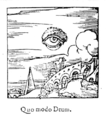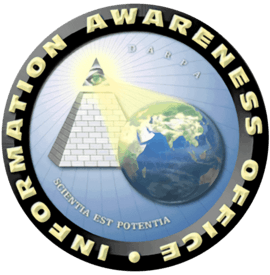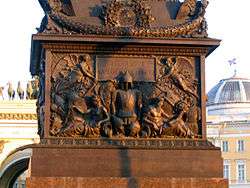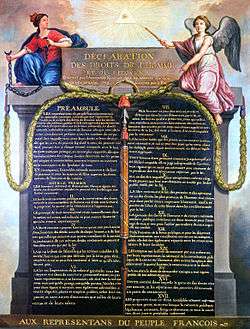Eye of Providence

The Eye of Providence (or the all-seeing eye of God) is a symbol showing an eye often surrounded by rays of light or a glory and usually enclosed by a triangle. It represents the eye of God watching over mankind (or divine providence).[1][2][3] In the modern era, a notable depiction of the eye is the reverse of the Great Seal of the United States, which appears on the United States one-dollar bill.
Religious use
The association of an eye with the concept of Divine Providence did not emerge until well into the Christian Era, in Renaissance European iconography, where it was an explicit image of the Christian Trinity. Seventeenth-century depictions of the Eye of Providence sometimes show it surrounded by clouds or sunbursts.[4]
United States

In 1782, the Eye of Providence was adopted as part of the symbolism on the reverse side of the Great Seal of the United States. It was first suggested as an element of the Great Seal by the first of three design committees in 1776 and is thought to be the suggestion of the artistic consultant, Pierre Eugene du Simitiere.[5]
In his original proposal to the committee, Du Simitiere placed the Eye over shields symbolizing each of the original thirteen states of the Union. On the version of the seal that was eventually approved, the Eye is positioned above an unfinished pyramid of thirteen steps (again symbolizing the original States, but incorporating the nation's potential for future growth). The symbolism is explained by the motto that appears above the Eye: Annuit Cœptis, meaning "[Providence] approves (or has approved) [our] undertakings".[6]
Perhaps due to its use in the design of the Great Seal, the Eye has made its way into other American seals and logos, for example: the Seal of Colorado and DARPA's Information Awareness Office.
Freemasonry

Today, the Eye of Providence is often associated with Freemasonry. The Eye first appeared as part of the standard iconography of the Freemasons in 1797, with the publication of Thomas Smith Webb's Freemasons Monitor.[7] Here, it represents the all-seeing eye of God and is a reminder that man's thoughts and deeds are always observed by God (who is referred to in Masonry as the Great Architect of the Universe). Typically, the Masonic Eye of Providence has a semi-circular glory below the eye. Sometimes the Eye is enclosed by a triangle.
Popular among conspiracy theorists is the claim that the Eye of Providence shown atop an unfinished pyramid on the Great Seal of the United States indicates the influence of Freemasonry in the founding of the United States. However, common Masonic use of the Eye dates to 14 years after the creation of the Great Seal. Furthermore, among the members of the various design committees for the Great Seal, only Benjamin Franklin was a Mason (and his ideas for the seal were not adopted). Indeed, many Masonic organizations have explicitly denied any connection to the creation of the Seal.[8][9]
Other uses
Coats of arms and seals
The Eye of Providence appears on many coats of arms and official seals, such as:
- The Coat of Arms of Brasłaŭ, Belarus
- The Coat of Arms of Kalvarija, Lithuania
- The Coat of Arms and Flag of Plungė, Lithuania
- The Coat of Arms and Flag of Šiauliai, Lithuania
- The Coat of Arms of Wilamowice, Poland
- Several college fraternities use the Eye of Providence in their coats of arms and/or badges, notably Delta Tau Delta, Phi Kappa Psi, Phi Delta Theta and Delta Kappa Epsilon
- The seal of the State of Colorado
- The seal of The University of Mississippi
- The seal of The University of Chile
- The seal of the city of Kenosha, Wisconsin.
Currency
The Eye appears on the following currency:
- United States one-dollar bill, as part of the Great Seal (see above)
- The 50 Estonian krooni note, as part of a depiction of the pipe organ of the Käina church
- The 500 Ukrainian hryvnia note
Miscellaneous
- On the original publication of the Declaration of the Rights of Man and of the Citizen, which also borrows iconography of the Ten Commandments
- On the front page of the Serbian Constitution of 1835
- The Kazan Cathedral, St. Petersburg, Russia
- The Salt Lake Temple, Salt Lake City, Utah
- Insignia of the UK Guards Division created in 1915
- The Steve Jackson Games logo
- Numerous video games, TV shows, films, books and websites contain depictions of the eye. A common occurrence is in the context of a reference to the Illuminati.
- The logo for the WWE tag team, The Ascension.
Pictures
-

Alchemical woodcut showing the all-seeing eye floating in the sky
-
All-seeing eye in a Cape Dutch gable in Stellenbosch, South Africa
-

Original seal of the DARPA Information Awareness Office
-

All-seeing eye on the pedestal decorations of Alexander Column
-

All-seeing eye on the top of the Declaration of Human Rights (1789), French Revolution
-

All-seeing eye in a pediment of an esoteric Christian temple in Mount Ecclesia, California
-
All-seeing eye on the gate of Aachen Cathedral
-

Eye of Providence depicted in the stained glass window of a church in Fifield, Wisconsin
-

God eye in West Ukraine (Ukrainian Carpathian) near village Mykulychyn. The inscription on the stone, translated from an old Ukrainian dialect into English reads: "All will pass but God's eye does not pass you."
-

A 1525 Jacopo Pontormo painting using the Eye of Providence in a triangle as a symbol of the Christian Trinity
-

Eye of Providence, Jewish cemetery in Kamienna Góra
-
Eye of Providence in the canting arms of the Jauch family (motto: ″Lord thou shalt guide me with thy counsel″, Psalm 73:24)
References
- ↑ "The eye as a Christian symbol". catholic-saints.com.
- ↑ "The Eye as a religious symbol". Religiousfacts.com.
- ↑ "Freemasonry and the All-seeing Eye". Grand Lodge of British Columbia and Yukon.
- ↑ Potts, Albert M. The World's Eye. University Press of Kentucky. pp. 68–78.
- ↑ The Great Seal of the United States booklet, published by US Dept. of State
- ↑ Greatseal.com: America's Number On the Great Seal
- ↑ S. Brent Morris, "The Eye in the Pyramid," from the Short Talk Bulletin of the Masonic Service Association of the United States. Last revised: 01/13/2010 22:34:20. Retrieved 4 March 2015.
- ↑ "Anti-masonry Frequently Asked Questions". Grand Lodge of British Columbia and Yukon.
- ↑ Barrett, David, W.Bro. "The "Masonic" One Dollar: Fact or Fiction?". Pietre-Stones Review of Freemasonry.
External links
-
 Media related to Eye of Providence at Wikimedia Commons
Media related to Eye of Providence at Wikimedia Commons


